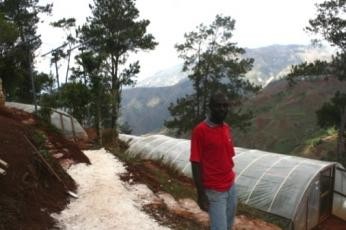
Michel Dorlean, a Haitian horticulturalist, grew up learning the family business of planting and growing flowers on hillside plots in his mountainous hometown of Furcy. Despite all the intensive work that goes into cultivating flowers, Dorlean and many other local flower producers struggled each year to reach their full earning potential.
The traditional hillside plots left their flowers vulnerable to excessive heat, humidity and rain; Dorlean used to lose upwards of 8 percent of his flower yields. The massive earthquake that struck Haiti in 2010 made matters worse, leading to a dramatic drop in prices that nearly forced farmers in Furcy to abandon flower production for more profitable crops.
Today, thanks to assistance from Feed the Future, Dorlean is the president of a flower growers’ association in Furcy that generates US$18,000 per year. The project, implemented through USAID, is teaching smallholder farmers like Dorlean and his association how to use greenhouse agriculture to produce a higher quantity and quality of crops on smaller areas of land. An average farmer using traditional methods makes $170 per year on a surface of 1,000 square meters, whereas one that owns a greenhouse can generate about $1,800 in a year on only a 70 square meter area—a staggering difference. Not only is Feed the Future increasing incomes for rural Haitians, but it is also helping reduce the environmental impact on water and soil resources.
Since 2009, Feed the Future has been working with farmers in the Kenscoff region of Haiti to promote sustainable agriculture on hillsides by focusing on protected and vertical agriculture through small, drip-irrigated greenhouses. Each of these efficient structures can generate revenues of more than $1,500 per year for local organizations. Feed the Future offers technical assistance to teach farmers not only how to build and operate a greenhouse, but also the financial management and business development skills that will make increased production sustainable over the long term.
By protecting flowers from humidity and rain, greenhouses can boost production to three harvests per year compared to the one or two farmers could count on using traditional mountainside plots. Since the flowers are drip-irrigated, the greenhouses use less water to generate greater outputs. “You only need three gallons of water to irrigate an entire greenhouse, compared to over 50 gallons needed outdoors for the same number of plants,” Dorlean says.
Two years after receiving targeted assistance from Feed the Future, Dorlean’s association is operating 10 greenhouses that are built on a newly terraced landscape to help protect the mountain against soil erosion. The association’s success has been so impressive that Haiti’s Ministry of Agriculture funded the construction of 10 additional greenhouses in the region. In return, Dorlean’s association will plant 7,000 trees as part of agro-forestry efforts to reduce soil erosion. Four new greenhouses have already been built with assistance from the Ministry of Agriculture, and the flower growers in Furcy are eager to share their knowledge with other members of the community.
Dorlean’s story is an example of the kind of sustainable models for agribusiness Feed the Future is helping to create in Haiti and elsewhere. By building the capacity of smallholder farmers, Feed the Future strives to increase agricultural production and the income of those who rely on agriculture for their livelihoods.







Comment
Make a general inquiry or suggest an improvement.